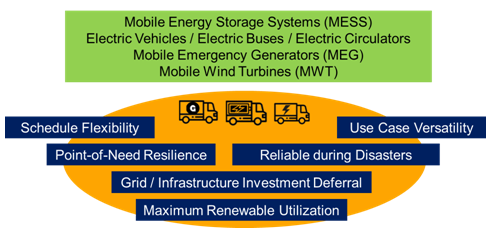Resilient Smart Cities: Addressing Extreme Events and Building Stronger Communities
Written by Abouzar Estebsari
Smart cities, equipped with advanced technologies and data-driven solutions, have emerged as a promising gateway to address urban challenges and enhance the quality of life for citizens. While these technologies can provide numerous benefits, they can also create new vulnerabilities and risks, making these ubiquitous cities more susceptible to a wide range of extreme events such as natural disasters, cyber-attacks, and pandemics, which can cause significant disruptions and put the safety and well-being of citizens at risk. For example, smart cities rely heavily on digital technologies and interconnected systems, which can be vulnerable to cyberattacks. Therefore, enhancing the resilience of smart cities is crucial to mitigate the impact of extreme events and ensure their sustainable development.
Introduction
Smart cities integrate various critical infrastructure sectors such as energy, transportation, and health, with advanced technologies like IoT, AI, and cloud computing [1]. Despite their numerous benefits, smart cities are vulnerable to extreme events that can disrupt their functionality and safety. Studies have explored the impact of extreme events on smart cities and proposed various resilience measures. Ashrafi et al. [2] proposed a multi-objective optimization framework to enhance the resilience of the smart grid against natural disasters such as floods and earthquakes. Similarly, Argyroudis et al. [3] suggested a resilience assessment methodology to identify critical assets and vulnerabilities in transportation infrastructure under extreme weather events. Integrating various technologies and data sources can also enhance smart city resilience. Big data analytics for real-time monitoring and risk assessment, and cloud-based emergency management systems to support decision-making during extreme events, are some examples of resilience enhancement technologies that can be adopted to realize resilient smart cities of the future.
Possible Extreme Events Affecting Smart Cities
Smart cities are particularly vulnerable to a range of extreme events whose sources can be natural or human-induced including but not limited to cyber-attacks, climate change, and pandemics. Cyber-attacks can cause major disruptions to the smart city's digital infrastructure, such as power grids, communication systems, and transportation networks. Climate change can lead to extreme weather events, such as hurricanes, floods, and heatwaves, that can cause significant damage to buildings and infrastructure [4]. Pandemics can also disrupt the normal functioning of a smart city by putting a strain on healthcare and emergency response systems, as well as social and economic sectors [5]. Therefore, it is crucial to develop resilience strategies in smart cities of the future that effectively address these sources of extreme events.
Challenges of Enhancing Resilience in Smart Cities
One of the major challenges is the lack of standardization and interoperability among the various smart city components [6], which can hinder their ability to respond to unexpected shocks. Another challenge is the security and privacy concerns associated with the deployment of smart city technologies. The integration of various components such as sensors, data storage systems, and communication networks can create new security vulnerabilities that can be exploited by cybercriminals. This cannot only compromise the privacy of citizens but also have serious implications for the overall resilience of the smart city ecosystem.
The complexity of smart city systems can make it difficult to ensure their resilience against a range of extreme events. There is a need for more sophisticated, yet effective, algorithms and models that can accurately predict the impact of extreme events on different smart city components, such as energy grids and transportation systems.
Solutions for Enhancing Resilience in Smart Cities
A number of solutions exist that could be used to enhance the resilience of smart cities to extreme events:- Enhancing redundancy: This can be achieved by incorporating backup systems and alternative options in case of failures. For example, smart cities can invest in microgrids and distributed energy resources to ensure an uninterrupted power supply during extreme weather events or cyber-attacks.
- Implementing early warning systems: Smart cities can deploy sensors and monitoring devices to detect potential hazards such as floods, landslides, or air pollution. For instance, Singapore has implemented a comprehensive flood warning system that leverages real-time data to provide timely alerts to citizens and emergency responders [7].
- Increasing systems flexibility: Smart cities can adopt dynamic demand-side management strategies that enable them to quickly adjust energy usage, transportation routes, and other critical systems in response to changing conditions. This can be achieved using smart algorithms and predictive analytics. Barcelona's Superblock project [8], as an example, incorporates smart traffic lights that can adjust signal timings in real time based on traffic flows.
- Enhancing cybersecurity: Smart cities can implement robust cybersecurity measures to protect critical infrastructure and sensitive data from cyber-attacks. This includes data encryption, access controls, and network segmentation. Amsterdam has implemented a city-wide cybersecurity plan that includes regular vulnerability assessments, security awareness training, and incident response protocols [9].
- Encouraging community participation: Smart cities can engage citizens and local communities in the planning and implementation of resilience strategies. This can include initiatives such as community gardens, urban forestry, and citizen science programs that promote environmental sustainability and social cohesion. The "Greenovate Boston" program is a good example of encouraging citizens to participate in sustainable initiatives such as energy efficiency and waste reduction [10].
Figure 1 summarizes the main extreme events affecting smart cities and the challenges and solutions for enhancing their resilience.
Figure 1: Enhancing Resilience in Smart Cities of the Future.
Conclusion
Smart cities leverage advanced technologies and methodologies to enhance the quality of services provided to society. However, this integration creates new vulnerabilities and risks, rendering smart cities more susceptible to a wide range of extreme events. Enhancing the resilience of smart cities is crucial to mitigate the impact of extreme events and ensuring their sustainable development. In practice, improving the resilience of smart cities to extreme events faces various challenges, including but not limited to the lack of standardization and interoperability, security and privacy issues, and the inherent complexity of the solutions. Several methods can be employed to strengthen resilience in smart cities, including increasing redundancy, implementing early warning systems, increasing system flexibility, enhancing cybersecurity, and promoting community participation. However, it should be noted that successful implementation of resilience measures depends on stakeholder involvement and citizen engagement in both the design and implementation of resilience strategies.
References
- A. Estebsari and E. Werna, "Smart Cities, Grids, Homes and the Workforce: Challenges and Prospects," in Current State of Art in Artificial Intelligence and Ubiquitous Cities, Springer, 2022, pp. 17-39. https://doi.org/10.1007/978-981-19-0737-1_2
- Ashrafi, R., Amirahmadi, M., Tolou-Askari, M. and Ghods, V., 2021. Multi-objective resilience enhancement program in smart grids during extreme weather conditions. International Journal of Electrical Power & Energy Systems, 129, p.106824.
- Argyroudis, S.A., Mitoulis, S.A., Hofer, L., Zanini, M.A., Tubaldi, E. and Frangopol, D.M., 2020. “Resilience assessment framework for critical infrastructure in a multi-hazard environment: Case study on transport assets,” Science of the Total Environment, 714, p.136854.
- S. A. Ahmed, L. S. Abouelnaga and T. Brahimi, "Mapping the Scientific Landscape of Smart Buildings and Climate Change," 2023 1st International Conference on Advanced Innovations in Smart Cities (ICAISC), Jeddah, Saudi Arabia, 2023, pp. 1-5, doi: 10.1109/ICAISC56366.2023.10085598.
- Amirzadeh, M., Sobhaninia, S., Buckman, S.T. and Sharifi, A., 2022. Towards building resilient cities to pandemics: A review of COVID-19 literature. Sustainable Cities and Society, p.104326.
- B. Ahlgren, M. Hidell and E. C. . -H. Ngai, "Internet of Things for Smart Cities: Interoperability and Open Data," in IEEE Internet Computing, vol. 20, no. 6, pp. 52-56, Nov.-Dec. 2016, doi: 10.1109/MIC.2016.124.
- Chan, F.K.S., Chuah, C.J., Ziegler, A.D., Dąbrowski, M. and Varis, O., 2018. “Towards resilient flood risk management for Asian coastal cities: Lessons learned from Hong Kong and Singapore,” Journal of Cleaner Production, 187, pp.576-589.
- Zografos, C., Klause, K.A., Connolly, J.J. and Anguelovski, I., 2020. The everyday politics of urban transformational adaptation: Struggles for authority and the Barcelona superblock project. Cities, 99, p.102613.
- Dameri, R.P. (2014). “Comparing Smart and Digital City: Initiatives and Strategies in Amsterdam and Genoa. Are They Digital and/or Smart?,” In: Dameri, R., Rosenthal-Sabroux, C. (eds) Smart City. Progress in IS. Springer, Cham. https://doi.org/10.1007/978-3-319-06160-3_3
- Groonovate Boston Program, https://www.greenovateboston.org, Accessed on 8 April 2023.
This article was edited by Melkior Ornik.
To view all articles in this issue, please go to April 2023 eNewsletter. For a downloadable copy, please visit the IEEE Smart Cities Resource Center.

To have the eNewsletter delivered monthly to your inbox, join the IEEE Smart Cities Community.
Past Issues
To view archived articles, and issues, which deliver rich insight into the forces shaping the future of the smart cities. Older eNewsletter can be found here. To download full issues, visit the publications section of the IEEE Smart Cities Resource Center.




